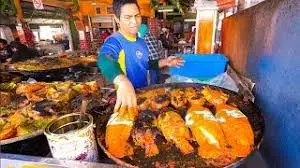The top 3 famous recipes of Malaysia?
Introduction
Malaysian cuisine is a vibrant tapestry of flavors, aromas, and textures, reflecting the country’s rich cultural heritage. With its unique blend of Malay, Chinese, Indian, and indigenous influences, every dish tells a story. From bustling street markets to elegant restaurants, food is an integral part of Malaysia’s identity.
Traveling through this Southeast Asian gem means savoring unforgettable meals that leave lasting impressions. Whether you’re a seasoned foodie or just beginning your culinary adventure, diving into Malaysian recipes opens up a world of taste sensations. Let’s explore three iconic dishes that have captured hearts—and stomachs—around the globe!
Nasi Lemak: The National Dish of Malaysia
Nasi lemak is often hailed as the heart of Malaysian cuisine. This dish beautifully captures the essence of local flavors and ingredients.
At its core, nasi lemak features fragrant rice cooked in coconut milk, giving it a rich and creamy texture. It’s typically served with sambal, a spicy chili paste that adds a fiery kick to each bite.
Accompanying elements include crispy anchovies, roasted peanuts, hard-boiled eggs, and slices of cucumber. Each ingredient enhances both flavor and presentation.
Traditionally enjoyed for breakfast, this iconic meal can be found at street stalls and restaurants across Malaysia at any time of day. Its popularity transcends boundaries; locals savor it just as much as tourists do.
Every plate tells a story steeped in culture while inviting everyone to explore the vibrant culinary landscape of Malaysia.
Char Kway Teow: A Popular Street Food
Char Kway Teow is a beloved dish that embodies the essence of Malaysian street food culture. This stir-fried noodle dish features flat rice noodles, expertly tossed with prawns, Chinese sausage, bean sprouts, and chives.
The secret lies in its high heat cooking method. The wok is heated to perfection, creating that signature smoky flavor known as “wok hei.” It’s this charred aroma that makes each bite irresistible.
Street vendors serve Char Kway Teow at bustling night markets across Malaysia. Each vendor has their own twist on the recipe, adding unique ingredients or spice levels to attract hungry patrons.
Whether enjoyed as a quick snack or a hearty meal, Char Kway Teow captures the vibrant spirit of Malaysia’s culinary landscape. Its rich flavors and satisfying texture make it a must-try for anyone exploring Malaysian cuisine.
Rendang: A Spicy and Flavorful Curry
Rendang is a culinary treasure that hails from the Minangkabau ethnic group of Indonesia, yet it has found a cherished place in Malaysian cuisine. This slow-cooked beef curry is renowned for its vibrant flavors and tender meat.
What sets rendang apart is its rich blend of spices. Ingredients like lemongrass, galangal, turmeric, and coconut milk come together to create layers of taste. The dish simmers until the sauce thickens and clings to the meat, infusing every bite with warmth.
Traditionally served at celebrations and special occasions, rendang embodies hospitality. It’s often accompanied by rice or flatbreads but can also stand alone as a hearty main dish.
Each family may have their own version of this beloved recipe. Some prefer it fiery hot while others lean towards milder notes. Regardless of preparation style, rendang remains an unforgettable staple in Malaysian dining culture.
The History and Cultural Significance of These Dishes
Malaysian cuisine reflects the country’s rich history and diverse cultures. Each dish tells a story woven from various influences, including Malay, Chinese, Indian, and indigenous traditions.
Nasi lemak is more than just food; it embodies Malaysian identity. Traditionally enjoyed for breakfast, this dish links generations through shared recipes passed down over time.
Char kway teow captures the essence of street life in Malaysia. Its quick preparation method mirrors the bustling lifestyle of urban centers while showcasing ingredients that symbolize local resources.
Rendang showcases cultural rituals and celebrations. This slow-cooked curry often graces festive occasions, illustrating hospitality through its complex flavors designed to impress guests.
Each recipe serves as a culinary bridge connecting people across different backgrounds, fostering community bonds while celebrating unique heritage in every bite.
Tips for Making Authentic Malaysian Recipes at Home
To create authentic Malaysian dishes, start with fresh ingredients. Look for local markets to find aromatic herbs like pandan leaves and lemongrass. These are essential for capturing the true essence of Malaysian cuisine.
Next, invest in the right spices. Ingredients such as coriander seeds, cumin, and turmeric powder elevate flavors significantly. Toasting whole spices before grinding can enhance their aroma.
Don’t shy away from experimenting with textures. Incorporate crispy fried shallots or toasted coconut into your recipes for added depth.
Practice layering flavors by adding ingredients step-by-step rather than all at once. This technique allows each flavor to shine through beautifully.
Embrace patience while cooking curries or stews. Slow-cooking intensifies the flavors and creates a richer taste that is characteristic of traditional Malaysian meals. Enjoy the process—cooking is an art!
Conclusion
Malaysian cuisine is a vibrant tapestry woven from various cultural influences and culinary traditions. The dishes we’ve explored—Nasi Lemak, Char Kway Teow, and Rendang—represent just a fraction of the rich flavors that define this Southeast Asian nation.
These recipes are not only delicious but also tell stories of Malaysia’s history and heritage. They showcase the country’s diverse ingredients and cooking methods, reflecting the fusion of Malay, Chinese, Indian, and indigenous cultures.
For those eager to recreate these famous dishes at home, remember that authenticity often lies in using fresh ingredients and traditional techniques. Don’t be afraid to experiment with spices; they are what truly elevate Malaysian cuisine.
Whether you’re enjoying Nasi Lemak as breakfast or savoring Char Kway Teow from a street vendor after dark, each meal offers an opportunity to connect with Malaysia’s culinary roots. So gather your ingredients and dive into these flavorful recipes for an unforgettable experience.





